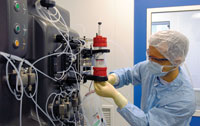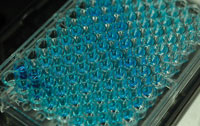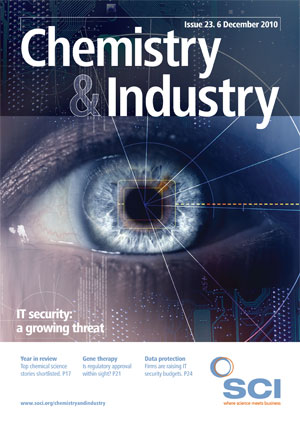The path to market for gene therapy companies has been long and much more difficult than anyone might have imagined. So far, there is not a single gene therapy on the market outside of China. But all of that may soon be about to change. ‘Glybera would be first gene therapy product approved in the Western world,’ says Jörn Aldag, ceo of Dutch based biotech company Amsterdam Molecular Therapeutics (AMT). ‘It would have a tremendous impact as this is the highest priority validation of our technology we can have.’

LPLD is caused by mutations in the LPL gene that affects roughly two in a million people. The LPL protein it encodes is needed to break down large fat-carrying particles that circulate in the blood after each meal, which can obstruct small blood vessels and result in pancreatitis and other complications if they are not removed. There is no treatment for LPLD and therapy is mostly by a restricted diet allowing virtually no fat.
‘Gene therapy [by a series of injections into the muscles] restores gene function and cures disease,’ Aldag says. ‘The first patients for Glybera began treatment five years ago and over the entire population of 27 patients we are seeing a reduction of incidence of pancreatitis of 70%.’
If approved, Glybera could be on the marketplace in the EU as early as 2011 and in Canada and the US in 2012. Therapy will initially be restricted to patients with the homozygous condition – with two faulty alleles on both chromosomes. Aldag says he expects Glybera could fetch €500-1bn in sales over 10 years, representing ‘a market opportunity of €50m/year on a worldwide basis, starting to ramp up in 2011.’

Following the ruling, in March this year Cerepro’s maker Ark Therapeutics reported that it was withdrawing its filing for the therapy and seeking partners to fund further a further trial as required by regulators in the EU and US. In September 2010, the company reported plans for a major restructuring of the business, a significant reduction in its fixed costs and the appointment of a new chairman.
Despite the setbacks, Ark ceo Martyn Williams says he remains optimistic about the regulatory environment for gene therapies. ‘Ark has carried out a lot of pioneering work with regulators and shown that gene therapies will be viewed by regulators as potentially approval products through normal regulatory processes,’ Williams says. However, ‘the current investment climate is tough for biotech companies generally,’ he adds. ‘Ark has demonstrated that gene therapy is approvable through its Cerepro MAA filing so we do not feel gene therapy is at a disadvantage with investors.’
Progress has also been slower than originally expected for cystic fibrosis (CF) – one of the earliest diseases targeted by gene therapy, which affects over 8500 people in the UK and occurs when two copies of the faulty CF gene are inherited. Roughly one in 25 people carries a faulty CF gene and if two carriers have a child, there is a one in four chance that it will have cystic fibrosis. Scientists showed that it was possible to correct the CF defect in cells in the lab two decades ago, shortly after the gene for CF was discovered. Since then, about 25 CF gene therapy trials have been performed, using both viruses and synthetic liposomes as the vector vehicles to carry the healthy gene into cells.
Researchers plan the first trials
In 2011, UK researchers finally plan to start the first trials to demonstrate efficacy as well as safety – whether CF gene therapy works in patients. ‘We hope to be treating 100 patients in Phase IIb trials starting in summer next year,’ says Eric Alton, professor of gene therapy at Imperial College London and coordinator of the UK Cystic Fibrosis Gene Therapy Consortium, also involving scientists at the universities of Edinburgh and Oxford. ‘We will be dosing patients repeatedly every month, which has never been done before. This will be the world’s first long-term multi-dose trial for CF.’
The big hurdle for CF and most other gene therapies, Alton says, has been delivery: how to get sufficient amounts of the healthy genes into cells and keep them functioning there. Usefully, cells only require 5-10% of healthy CF protein to function normally, and only 5-10% of cells need to achieve that level, he explains; so far the consortium is ‘pretty close to achieving these levels’.
The therapy – an inhalable aerosol in which the healthy genes are contained in liquid droplets – will not be a cure for CF, Alton says; however, it could dramatically increase a patient’s lifespan by preventing the build up of mucus in the lungs ,which is ultimately the main cause of death. Because the therapy will need to be re-administered to patients every month, the group has opted to use synthetic lipid vectors that can better evade detection by the body’s immune system.
The other big challenges have been identifying suitable biomarkers to show clinical outcomes, and in selecting the appropriate patient groups for study. ‘It has taken us over eight years and more than £40m funding to get to the point we are. In the end we learned we have to pool resources so that all three groups in the UK have come together to form the consortium,’ Alton says. ‘You can't do it all on your own.’
The group has also been working closely with Genzyme, which supplies the lipid in the current vector and with whom the original proof-ofconcept studies were done.
Longer term, the consortium also has in the pipeline a ‘Wave 2’ therapy based on a Lentivirus species, which could potentially offer a one off treatment for CF – ‘a single hit gene therapy for life’, Alton says. Unlike other vectors, viruses such as lentiviruses and retroviruses actually insert their DNA directly into the cellular DNA, he explains, and so potentially offer a long-term treatment. Evidence for the effectiveness of gene therapies, meanwhile, continues to grow as more trials deliver results. ‘The majority of gene therapy trials worldwide have been carried out for cardiovascular disease and cancer,’ says Steve Howe, a gene therapy expert at the UK¹s UCL Institute of Child Health (ICH). ‘However, it is generally perceived that gene therapy for SCID [severe combined immunodeficiencies] has been the most successful application.’
SCID, otherwise known as ‘boy in the bubble syndrome’, affects one in every 50,000-100,000 male births in the UK. Boys with the condition lack an immune system and were at one time forced to live in protective ‘bubbles’ to avoid infection. The usual method of treatment is by bone marrow transplantation, a long and difficult procedure that can be risky if a perfect donor is not found.
Over the past decade, ICH and London’s Great Ormond Street Hospital for Children have now carried out gene therapy trials in ten boys affected by SCID-X1, the form of SCID that is carried on the X-chromosome. Bone marrow stem cells from each child were removed and treated with an engineered retrovirus before the corrected cells were re-infused back into the patient to restore his immune system. ‘Rhys [Evans] the first patient we treated in the clinical trial for SCID-X1 in 2001, has recently celebrated his 10th birthday,’ Howe reports, while ‘all 10 patients developed a functional immune system, remain healthy and are living at home.’
These successes, however, have been overshadowed by serious safety concerns. Five patients involved in SCID gene therapy trials – four in French trials and one in the UK – later developed leukaemia. One of the French patients died. Researchers discovered that the vector had inadvertently switched on cellular genes involved in cancer. ‘The gammaretroviral vector used in the SCIDX1 trial integrates its genetic payload into the host cell chromosomes,’ Howe explains. ‘This is essential for long term correction of defective blood cells, but also carries a risk of insertional mutagenesis, altering expression levels of endogenous, cellular genes close to the insertion site in the genome.’ More recent ICH trials use newer vectors that reduce the risks of this occurring, he says.
As well as SCID, ICH researchers have also carried out other gene therapy trials, including for ADA [adenosine deaminase deficiency] and CGD [chronic granulomatus disease]. All of the trials to date have been Phase I/II with the primary goal to evaluate safety, and the secondary aim of alleviating disease, Howe points out. A total of 20 patients have been treated for SCID-X1, CGD and ADA and, although Howe says it is impossible to speak of patients being cured as the trials are still under way, ‘in most cases, the patients have recovered with a functional immune system and are clinically well, living normal lives.’
While regulatory approval for gene therapies has been slow in coming, nevertheless it appears that a small number of patients are already seeing the benefits of therapies in the clinic. Evidence for both the effectiveness and safety of gene therapies is growing as researchers continue to make slow but steady progress. Further into the future, meanwhile, new precision genetic engineering technologies promise to open up therapies for an even wider range of diseases. ‘The efficiency at which we can directly correct gene sequences, rather than just augment a missing function, is currently very low,’ Howe acknowledges. ‘However, cutting the target gene improves the rate of correction and new developments in zinc finger nuclease and meganuclease technology is slowly enhancing the technique. As many different mutations can cause disease we are focusing on the most commonly occurring genetic lesions, but eventually this technology could be used for individualised medicine for many different genetic diseases.’





